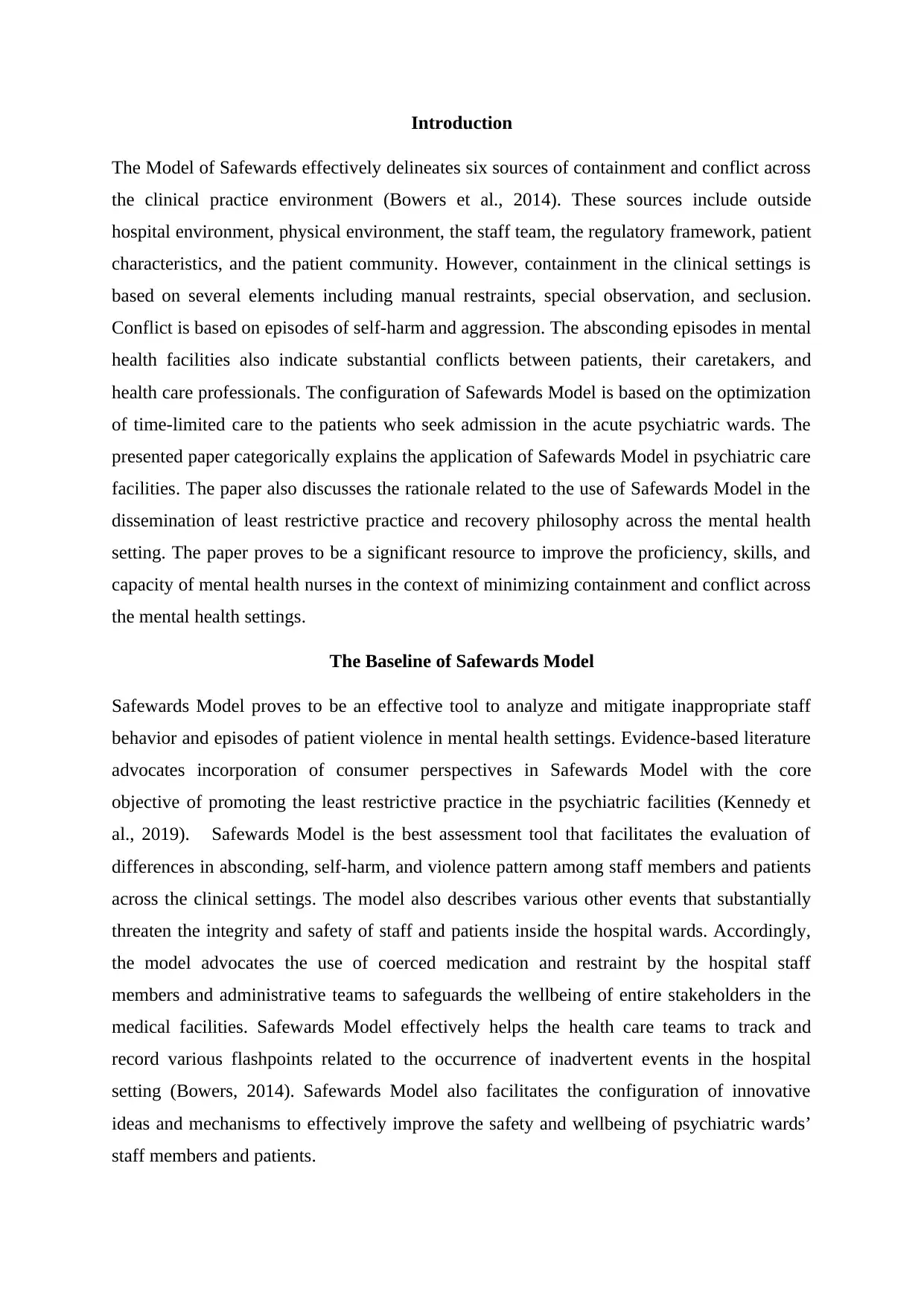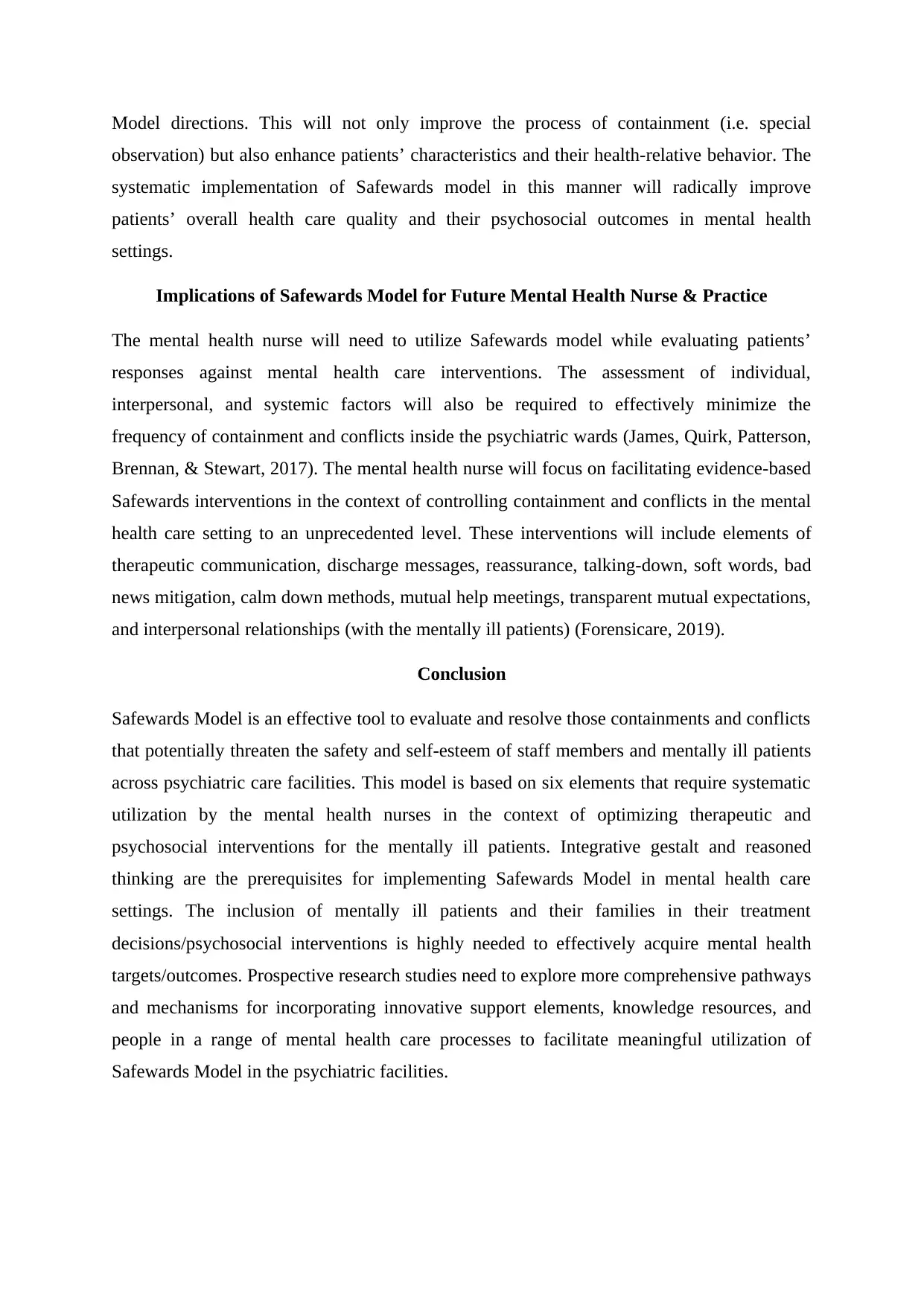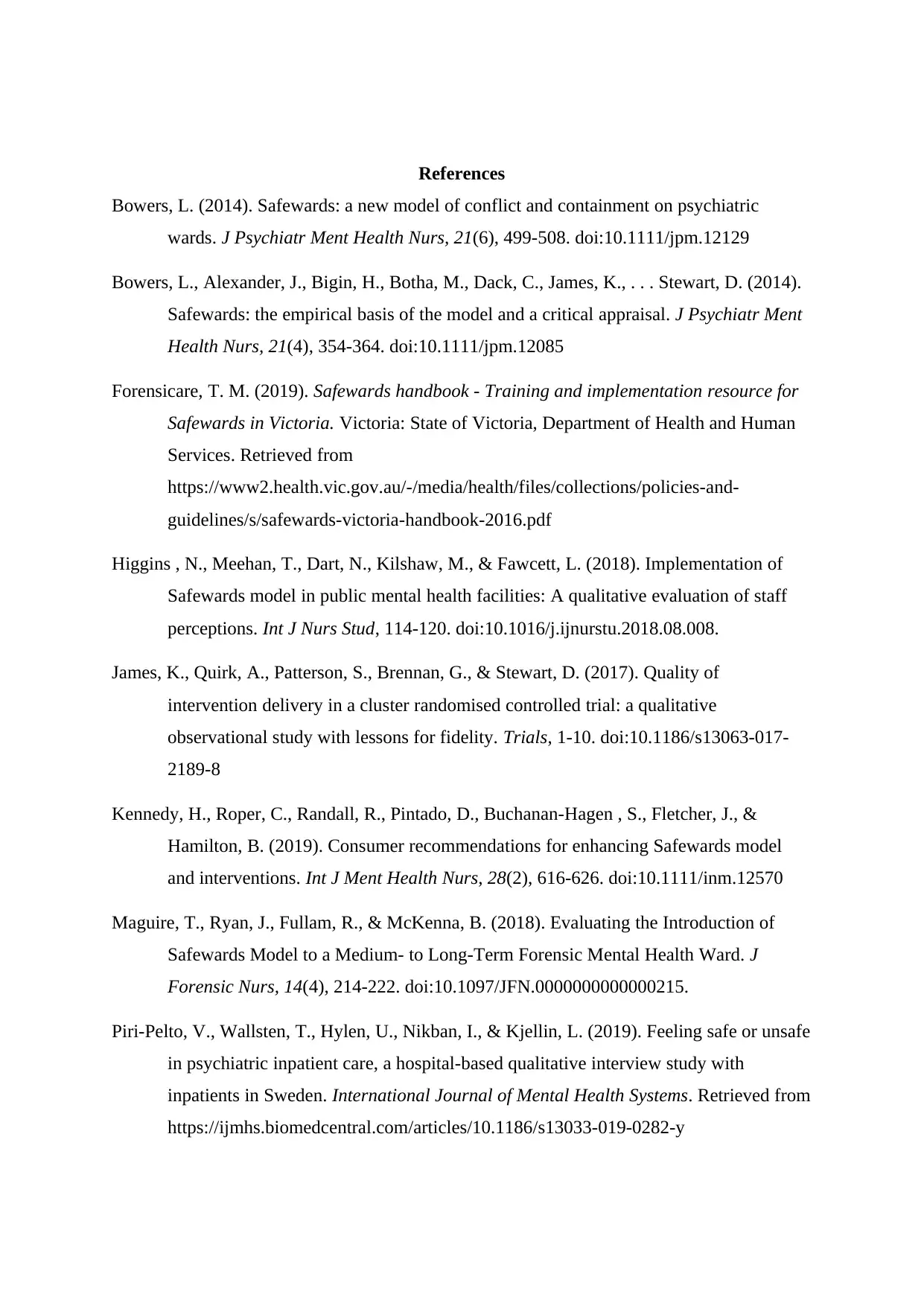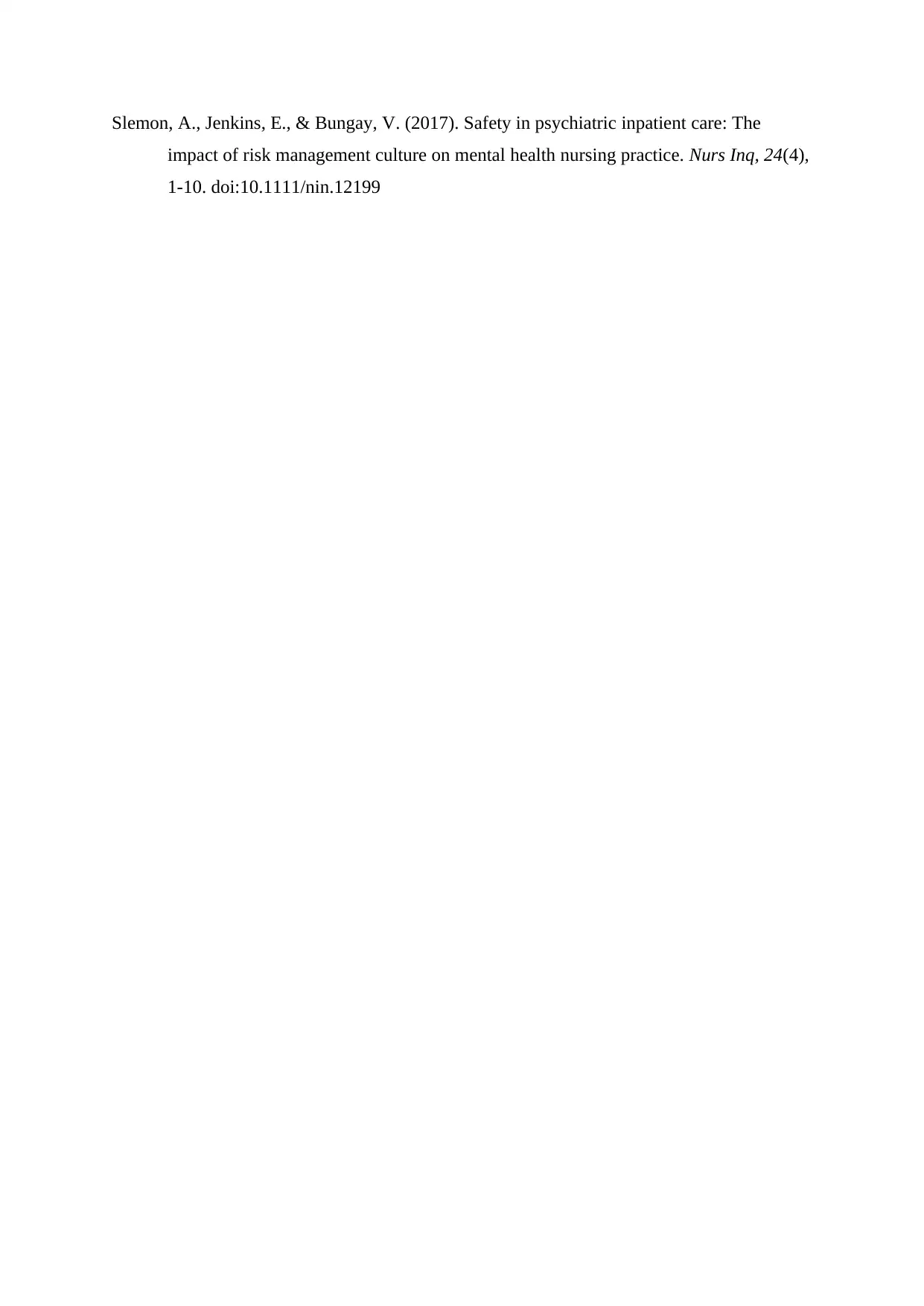Safewards Model: An Effective Tool for Minimizing Containment and Conflict in Psychiatric Care Facilities
VerifiedAdded on 2023/06/09
|5
|1635
|353
AI Summary
This paper discusses the application of Safewards Model in psychiatric care facilities. It explains the rationale related to the use of Safewards Model in the dissemination of least restrictive practice and recovery philosophy across the mental health setting. The paper proves to be a significant resource to improve the proficiency, skills, and capacity of mental health nurses in the context of minimizing containment and conflict across the mental health settings.
Contribute Materials
Your contribution can guide someone’s learning journey. Share your
documents today.

Introduction
The Model of Safewards effectively delineates six sources of containment and conflict across
the clinical practice environment (Bowers et al., 2014). These sources include outside
hospital environment, physical environment, the staff team, the regulatory framework, patient
characteristics, and the patient community. However, containment in the clinical settings is
based on several elements including manual restraints, special observation, and seclusion.
Conflict is based on episodes of self-harm and aggression. The absconding episodes in mental
health facilities also indicate substantial conflicts between patients, their caretakers, and
health care professionals. The configuration of Safewards Model is based on the optimization
of time-limited care to the patients who seek admission in the acute psychiatric wards. The
presented paper categorically explains the application of Safewards Model in psychiatric care
facilities. The paper also discusses the rationale related to the use of Safewards Model in the
dissemination of least restrictive practice and recovery philosophy across the mental health
setting. The paper proves to be a significant resource to improve the proficiency, skills, and
capacity of mental health nurses in the context of minimizing containment and conflict across
the mental health settings.
The Baseline of Safewards Model
Safewards Model proves to be an effective tool to analyze and mitigate inappropriate staff
behavior and episodes of patient violence in mental health settings. Evidence-based literature
advocates incorporation of consumer perspectives in Safewards Model with the core
objective of promoting the least restrictive practice in the psychiatric facilities (Kennedy et
al., 2019). Safewards Model is the best assessment tool that facilitates the evaluation of
differences in absconding, self-harm, and violence pattern among staff members and patients
across the clinical settings. The model also describes various other events that substantially
threaten the integrity and safety of staff and patients inside the hospital wards. Accordingly,
the model advocates the use of coerced medication and restraint by the hospital staff
members and administrative teams to safeguards the wellbeing of entire stakeholders in the
medical facilities. Safewards Model effectively helps the health care teams to track and
record various flashpoints related to the occurrence of inadvertent events in the hospital
setting (Bowers, 2014). Safewards Model also facilitates the configuration of innovative
ideas and mechanisms to effectively improve the safety and wellbeing of psychiatric wards’
staff members and patients.
The Model of Safewards effectively delineates six sources of containment and conflict across
the clinical practice environment (Bowers et al., 2014). These sources include outside
hospital environment, physical environment, the staff team, the regulatory framework, patient
characteristics, and the patient community. However, containment in the clinical settings is
based on several elements including manual restraints, special observation, and seclusion.
Conflict is based on episodes of self-harm and aggression. The absconding episodes in mental
health facilities also indicate substantial conflicts between patients, their caretakers, and
health care professionals. The configuration of Safewards Model is based on the optimization
of time-limited care to the patients who seek admission in the acute psychiatric wards. The
presented paper categorically explains the application of Safewards Model in psychiatric care
facilities. The paper also discusses the rationale related to the use of Safewards Model in the
dissemination of least restrictive practice and recovery philosophy across the mental health
setting. The paper proves to be a significant resource to improve the proficiency, skills, and
capacity of mental health nurses in the context of minimizing containment and conflict across
the mental health settings.
The Baseline of Safewards Model
Safewards Model proves to be an effective tool to analyze and mitigate inappropriate staff
behavior and episodes of patient violence in mental health settings. Evidence-based literature
advocates incorporation of consumer perspectives in Safewards Model with the core
objective of promoting the least restrictive practice in the psychiatric facilities (Kennedy et
al., 2019). Safewards Model is the best assessment tool that facilitates the evaluation of
differences in absconding, self-harm, and violence pattern among staff members and patients
across the clinical settings. The model also describes various other events that substantially
threaten the integrity and safety of staff and patients inside the hospital wards. Accordingly,
the model advocates the use of coerced medication and restraint by the hospital staff
members and administrative teams to safeguards the wellbeing of entire stakeholders in the
medical facilities. Safewards Model effectively helps the health care teams to track and
record various flashpoints related to the occurrence of inadvertent events in the hospital
setting (Bowers, 2014). Safewards Model also facilitates the configuration of innovative
ideas and mechanisms to effectively improve the safety and wellbeing of psychiatric wards’
staff members and patients.
Secure Best Marks with AI Grader
Need help grading? Try our AI Grader for instant feedback on your assignments.

Safewards Model’s Implications in the least Restrictive Practice and Recovery
Philosophy
Safewards Model advocates the development of unit guidelines for mentally ill patients and
psychiatric nurses in the context of accomplishing mutual expectations (Slemon, Jenkins, &
Bungay, 2017). The mental health nurses should utilize Safewards Model for evaluating
patients’ potential and responsiveness against inadvertent circumstances or bad news.
Subsequently, the mental health nurse should develop appropriate strategies for debriefing
and discussing the bad news with the concerned patients. Safewards Model advocates the
safeguarding of the patients’ emotional wellbeing while mitigating the negative potential of
unfavorable circumstances or episodes (Slemon et al., 2017). The model also emphasizes the
requirement of risk alignment and relocation to the hospital environment beyond the
boundaries of the psychiatric ward. Resultantly, Safewards Model signifies the need for
expanding the scope for strengthening patient safety in a manner to prevent iatrogenic
conditions and related psychosocial complications in the mental health setting.
Safewards Model presents a balanced approach regarding the optimization of least restrictive
interventions in accordance with the degree of patients’ self-harm and aggression risks in the
mental health facilities (Maguire, Ryan, Fullam, & McKenna, 2018). The assessment of the
hospital’s physical environment and patients’ characteristics are highly needed for the
effective enhancement of organizational values and good managerial practices while defining
the purpose of care for the mentally ill patients. These policies in accordance with Safewards
Model will guide the health care teams to impose reasonable restrictions on aggressive and
violent patients while concomitantly extending compassionate care in the absence of undue
coercion (Piri-Pelto, Wallsten, Hylen, Nikban, & Kjellin, 2019). The enhancement/promotion
of an effective regulatory framework and patient community engagement in the mental health
care facility should be done in a manner to elevate the level of staff-patient interaction
(Higgins, Meehan, Dart, Kilshaw, & Fawcett, 2018). The improvement in staff-patient
communication is substantially warranted to promote an environment of trust and confidence
in the mental health care facility.
The mental health care setting’s recovery philosophy should effectively encourage consumer
recommendations in the context of minimizing the use of restraints and seclusion in the
psychiatric wards. Accordingly, mental health nurse must acquire the privilege to engage the
family members of mentally ill patients in their psychosocial care while following Safewards
Philosophy
Safewards Model advocates the development of unit guidelines for mentally ill patients and
psychiatric nurses in the context of accomplishing mutual expectations (Slemon, Jenkins, &
Bungay, 2017). The mental health nurses should utilize Safewards Model for evaluating
patients’ potential and responsiveness against inadvertent circumstances or bad news.
Subsequently, the mental health nurse should develop appropriate strategies for debriefing
and discussing the bad news with the concerned patients. Safewards Model advocates the
safeguarding of the patients’ emotional wellbeing while mitigating the negative potential of
unfavorable circumstances or episodes (Slemon et al., 2017). The model also emphasizes the
requirement of risk alignment and relocation to the hospital environment beyond the
boundaries of the psychiatric ward. Resultantly, Safewards Model signifies the need for
expanding the scope for strengthening patient safety in a manner to prevent iatrogenic
conditions and related psychosocial complications in the mental health setting.
Safewards Model presents a balanced approach regarding the optimization of least restrictive
interventions in accordance with the degree of patients’ self-harm and aggression risks in the
mental health facilities (Maguire, Ryan, Fullam, & McKenna, 2018). The assessment of the
hospital’s physical environment and patients’ characteristics are highly needed for the
effective enhancement of organizational values and good managerial practices while defining
the purpose of care for the mentally ill patients. These policies in accordance with Safewards
Model will guide the health care teams to impose reasonable restrictions on aggressive and
violent patients while concomitantly extending compassionate care in the absence of undue
coercion (Piri-Pelto, Wallsten, Hylen, Nikban, & Kjellin, 2019). The enhancement/promotion
of an effective regulatory framework and patient community engagement in the mental health
care facility should be done in a manner to elevate the level of staff-patient interaction
(Higgins, Meehan, Dart, Kilshaw, & Fawcett, 2018). The improvement in staff-patient
communication is substantially warranted to promote an environment of trust and confidence
in the mental health care facility.
The mental health care setting’s recovery philosophy should effectively encourage consumer
recommendations in the context of minimizing the use of restraints and seclusion in the
psychiatric wards. Accordingly, mental health nurse must acquire the privilege to engage the
family members of mentally ill patients in their psychosocial care while following Safewards

Model directions. This will not only improve the process of containment (i.e. special
observation) but also enhance patients’ characteristics and their health-relative behavior. The
systematic implementation of Safewards model in this manner will radically improve
patients’ overall health care quality and their psychosocial outcomes in mental health
settings.
Implications of Safewards Model for Future Mental Health Nurse & Practice
The mental health nurse will need to utilize Safewards model while evaluating patients’
responses against mental health care interventions. The assessment of individual,
interpersonal, and systemic factors will also be required to effectively minimize the
frequency of containment and conflicts inside the psychiatric wards (James, Quirk, Patterson,
Brennan, & Stewart, 2017). The mental health nurse will focus on facilitating evidence-based
Safewards interventions in the context of controlling containment and conflicts in the mental
health care setting to an unprecedented level. These interventions will include elements of
therapeutic communication, discharge messages, reassurance, talking-down, soft words, bad
news mitigation, calm down methods, mutual help meetings, transparent mutual expectations,
and interpersonal relationships (with the mentally ill patients) (Forensicare, 2019).
Conclusion
Safewards Model is an effective tool to evaluate and resolve those containments and conflicts
that potentially threaten the safety and self-esteem of staff members and mentally ill patients
across psychiatric care facilities. This model is based on six elements that require systematic
utilization by the mental health nurses in the context of optimizing therapeutic and
psychosocial interventions for the mentally ill patients. Integrative gestalt and reasoned
thinking are the prerequisites for implementing Safewards Model in mental health care
settings. The inclusion of mentally ill patients and their families in their treatment
decisions/psychosocial interventions is highly needed to effectively acquire mental health
targets/outcomes. Prospective research studies need to explore more comprehensive pathways
and mechanisms for incorporating innovative support elements, knowledge resources, and
people in a range of mental health care processes to facilitate meaningful utilization of
Safewards Model in the psychiatric facilities.
observation) but also enhance patients’ characteristics and their health-relative behavior. The
systematic implementation of Safewards model in this manner will radically improve
patients’ overall health care quality and their psychosocial outcomes in mental health
settings.
Implications of Safewards Model for Future Mental Health Nurse & Practice
The mental health nurse will need to utilize Safewards model while evaluating patients’
responses against mental health care interventions. The assessment of individual,
interpersonal, and systemic factors will also be required to effectively minimize the
frequency of containment and conflicts inside the psychiatric wards (James, Quirk, Patterson,
Brennan, & Stewart, 2017). The mental health nurse will focus on facilitating evidence-based
Safewards interventions in the context of controlling containment and conflicts in the mental
health care setting to an unprecedented level. These interventions will include elements of
therapeutic communication, discharge messages, reassurance, talking-down, soft words, bad
news mitigation, calm down methods, mutual help meetings, transparent mutual expectations,
and interpersonal relationships (with the mentally ill patients) (Forensicare, 2019).
Conclusion
Safewards Model is an effective tool to evaluate and resolve those containments and conflicts
that potentially threaten the safety and self-esteem of staff members and mentally ill patients
across psychiatric care facilities. This model is based on six elements that require systematic
utilization by the mental health nurses in the context of optimizing therapeutic and
psychosocial interventions for the mentally ill patients. Integrative gestalt and reasoned
thinking are the prerequisites for implementing Safewards Model in mental health care
settings. The inclusion of mentally ill patients and their families in their treatment
decisions/psychosocial interventions is highly needed to effectively acquire mental health
targets/outcomes. Prospective research studies need to explore more comprehensive pathways
and mechanisms for incorporating innovative support elements, knowledge resources, and
people in a range of mental health care processes to facilitate meaningful utilization of
Safewards Model in the psychiatric facilities.

References
Bowers, L. (2014). Safewards: a new model of conflict and containment on psychiatric
wards. J Psychiatr Ment Health Nurs, 21(6), 499-508. doi:10.1111/jpm.12129
Bowers, L., Alexander, J., Bigin, H., Botha, M., Dack, C., James, K., . . . Stewart, D. (2014).
Safewards: the empirical basis of the model and a critical appraisal. J Psychiatr Ment
Health Nurs, 21(4), 354-364. doi:10.1111/jpm.12085
Forensicare, T. M. (2019). Safewards handbook - Training and implementation resource for
Safewards in Victoria. Victoria: State of Victoria, Department of Health and Human
Services. Retrieved from
https://www2.health.vic.gov.au/-/media/health/files/collections/policies-and-
guidelines/s/safewards-victoria-handbook-2016.pdf
Higgins , N., Meehan, T., Dart, N., Kilshaw, M., & Fawcett, L. (2018). Implementation of
Safewards model in public mental health facilities: A qualitative evaluation of staff
perceptions. Int J Nurs Stud, 114-120. doi:10.1016/j.ijnurstu.2018.08.008.
James, K., Quirk, A., Patterson, S., Brennan, G., & Stewart, D. (2017). Quality of
intervention delivery in a cluster randomised controlled trial: a qualitative
observational study with lessons for fidelity. Trials, 1-10. doi:10.1186/s13063-017-
2189-8
Kennedy, H., Roper, C., Randall, R., Pintado, D., Buchanan-Hagen , S., Fletcher, J., &
Hamilton, B. (2019). Consumer recommendations for enhancing Safewards model
and interventions. Int J Ment Health Nurs, 28(2), 616-626. doi:10.1111/inm.12570
Maguire, T., Ryan, J., Fullam, R., & McKenna, B. (2018). Evaluating the Introduction of
Safewards Model to a Medium- to Long-Term Forensic Mental Health Ward. J
Forensic Nurs, 14(4), 214-222. doi:10.1097/JFN.0000000000000215.
Piri-Pelto, V., Wallsten, T., Hylen, U., Nikban, I., & Kjellin, L. (2019). Feeling safe or unsafe
in psychiatric inpatient care, a hospital-based qualitative interview study with
inpatients in Sweden. International Journal of Mental Health Systems. Retrieved from
https://ijmhs.biomedcentral.com/articles/10.1186/s13033-019-0282-y
Bowers, L. (2014). Safewards: a new model of conflict and containment on psychiatric
wards. J Psychiatr Ment Health Nurs, 21(6), 499-508. doi:10.1111/jpm.12129
Bowers, L., Alexander, J., Bigin, H., Botha, M., Dack, C., James, K., . . . Stewart, D. (2014).
Safewards: the empirical basis of the model and a critical appraisal. J Psychiatr Ment
Health Nurs, 21(4), 354-364. doi:10.1111/jpm.12085
Forensicare, T. M. (2019). Safewards handbook - Training and implementation resource for
Safewards in Victoria. Victoria: State of Victoria, Department of Health and Human
Services. Retrieved from
https://www2.health.vic.gov.au/-/media/health/files/collections/policies-and-
guidelines/s/safewards-victoria-handbook-2016.pdf
Higgins , N., Meehan, T., Dart, N., Kilshaw, M., & Fawcett, L. (2018). Implementation of
Safewards model in public mental health facilities: A qualitative evaluation of staff
perceptions. Int J Nurs Stud, 114-120. doi:10.1016/j.ijnurstu.2018.08.008.
James, K., Quirk, A., Patterson, S., Brennan, G., & Stewart, D. (2017). Quality of
intervention delivery in a cluster randomised controlled trial: a qualitative
observational study with lessons for fidelity. Trials, 1-10. doi:10.1186/s13063-017-
2189-8
Kennedy, H., Roper, C., Randall, R., Pintado, D., Buchanan-Hagen , S., Fletcher, J., &
Hamilton, B. (2019). Consumer recommendations for enhancing Safewards model
and interventions. Int J Ment Health Nurs, 28(2), 616-626. doi:10.1111/inm.12570
Maguire, T., Ryan, J., Fullam, R., & McKenna, B. (2018). Evaluating the Introduction of
Safewards Model to a Medium- to Long-Term Forensic Mental Health Ward. J
Forensic Nurs, 14(4), 214-222. doi:10.1097/JFN.0000000000000215.
Piri-Pelto, V., Wallsten, T., Hylen, U., Nikban, I., & Kjellin, L. (2019). Feeling safe or unsafe
in psychiatric inpatient care, a hospital-based qualitative interview study with
inpatients in Sweden. International Journal of Mental Health Systems. Retrieved from
https://ijmhs.biomedcentral.com/articles/10.1186/s13033-019-0282-y
Secure Best Marks with AI Grader
Need help grading? Try our AI Grader for instant feedback on your assignments.

Slemon, A., Jenkins, E., & Bungay, V. (2017). Safety in psychiatric inpatient care: The
impact of risk management culture on mental health nursing practice. Nurs Inq, 24(4),
1-10. doi:10.1111/nin.12199
impact of risk management culture on mental health nursing practice. Nurs Inq, 24(4),
1-10. doi:10.1111/nin.12199
1 out of 5
Related Documents
Your All-in-One AI-Powered Toolkit for Academic Success.
+13062052269
info@desklib.com
Available 24*7 on WhatsApp / Email
![[object Object]](/_next/static/media/star-bottom.7253800d.svg)
Unlock your academic potential
© 2024 | Zucol Services PVT LTD | All rights reserved.





